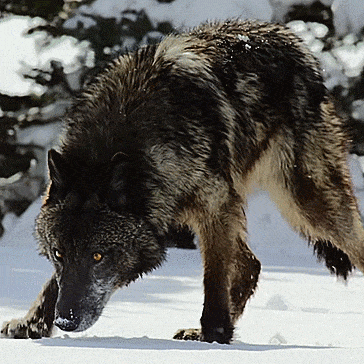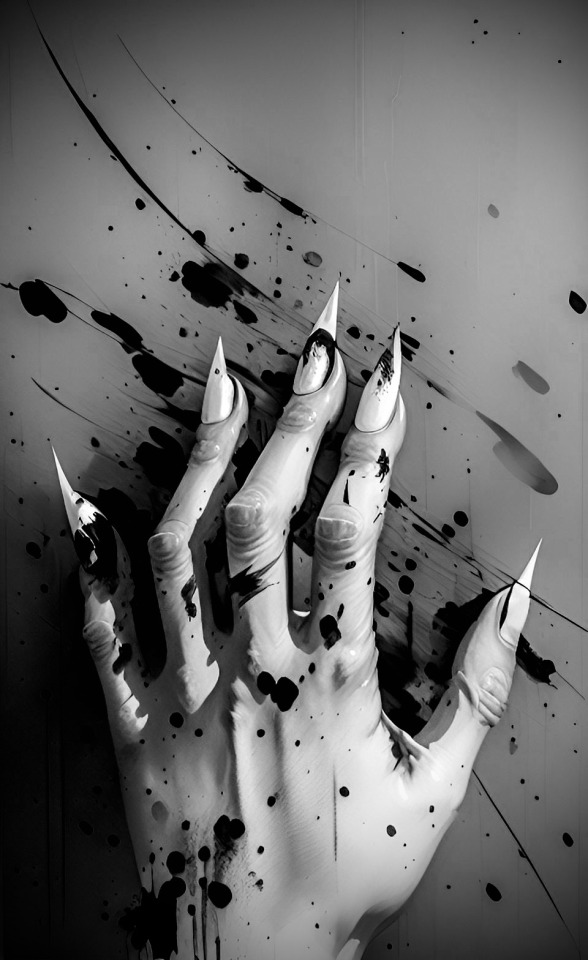#hamramr
Text
I asked SnapchatAI to write up an argument for using the Hail rune for shapeshifting practices, specifically with wolf spirits in the Norse context. These thoughts have been supported by Shani Oates’ book Wolfs-Head.
I’m surprised to say that it isn’t horrible.
-
The Hail Rune & Hamramr

The Old Norse rune poem describes the rune Hagalaz as being associated with hail, which can be seen as a symbol of destruction and chaos. However, some scholars have suggested that the rune may also represent the transformative power of change and upheaval, making it a good candidate to represent the wolf in the Norse context.
The wolf was an important symbol in Norse mythology, representing both danger and protection. The god Odin was often depicted with two wolves by his side, named Geri and Freki, who were said to be his constant companions. The wolf was also associated with the god Tyr, who sacrificed his hand to the wolf Fenrir in order to bind him and prevent him from destroying the world.
The concept of hamramr, or "shape-shifting," was also an important part of Norse mythology. Warriors were said to be able to take on the form of animals, including wolves, in order to gain strength and power in battle. The wolf was seen as a particularly powerful and fearsome animal, making it a popular choice for those who wished to take on its form.
The rune Hagalaz, with its associations with destruction and transformation, could be seen as a fitting symbol for the wolf in the Norse context. Its angular shape and jagged lines could represent the sharp teeth and claws of the wolf, while its association with hail could be seen as a metaphor for the wolf's ferocity and power.
Overall, while the Old Norse rune poem does not specifically mention wolves or any other animals, the rune Hagalaz could be seen as a good candidate to represent the wolf in the Norse context, particularly in the context of hamramr or shape-shifting. Its associations with destruction and transformation make it a powerful symbol that could be used to evoke the spirit of the wolf in Norse mythology.
How to use the Hail rune to connect with the Wolf spirit in your practice

Connecting with one's wolf spirit can be a powerful experience, allowing an individual to tap into their inner strength, courage, and intuition. The Hagalaz rune can be used as a magical tool to help facilitate this connection, by harnessing its transformative power and associations with the wolf.
One way to use the Hagalaz rune to connect with one's wolf spirit is to meditate on the rune, focusing on its shape, energy, and associations. Visualize the rune as a gateway or portal to the world of the wolf, and allow yourself to be drawn through it, feeling the transformational power of the rune as you shift into your wolf form.
Once you have connected with your wolf spirit, you can work with the Hagalaz rune to help strengthen and empower your connection. You might carve the rune into a piece of wood or stone, or draw it on a piece of paper, and use it as a talisman to carry with you. You could also incorporate the rune into a ritual or spell, invoking the transformative power of the rune to help you connect with your wolf spirit and access its strength and wisdom.
Overall, the Hagalaz rune can be a powerful tool for those seeking to connect with their wolf spirit. By harnessing its transformative power and associations with the wolf, you can tap into your inner strength, courage, and intuition, and awaken the power of your wolf spirit within.
#nature#magic#heathen#animist#wolf#hamr#hamramr#seidr#hail rune#hagalaz#odin#Norse magic#shapeshifting#shapeshifter
5 notes
·
View notes
Text
This post is purely me taking notes as I learn about the topic of the soul through a norse lense
The Hamr
Hamr (pronounced like the English word “hammer”) literally translates to “shape” or “skin.” The hamr is one’s form or appearance, that which others perceive through sensory observation. Unlike in our modern worldview, however, that which is perceived by the senses is not absolutely and unalterably static and fixed. In fact, hamr is the most crucial word in the Old Norse lexicon of shapeshifting. The Old Norse phrase that denotes the process of shapeshifting is skipta hömum, “changing hamr,” and the quality of being able to perform this feat is called hamramr, “of strong hamr.”[2]
Need to look into connections between "changing hamr" and transness
The Hugr
Hugr can be most satisfactorily translated as “thought” or “mind.” It corresponds to someone’s personality and conscious cognitive processes, and therefore overlaps considerably with what we today would call someone’s “inner self.”[3]
The hugr generally stays within its “owner,” but can at times create effects in faraway people just by thinking about them in a certain way. This is particularly possible for people who are described as having an exceptionally strong hugr.[4]
The Fylgja
Remember the cats, ravens, and other familiar spirits who are often the companions of witches in European folktales? These are fylgjur (pronounced “FILG-yur”) in the plural and fylgja (pronounced “FILG-ya”) in the singular. The fylgja is generally perceived in an animal form by those with second sight, although human fylgjur aren’t unheard-of. It’s an attendant spirit whose well-being is intimately tied to that of its owner – for example, if the fylgja dies, its owner dies, too. Its character and form are closely connected to the character of its owner; a person of noble birth might have a bear fylgja, a savage and violent person, a wolf, or a gluttonous person, a pig.
Fylgja literally translates as “follower,” but, as often as not, it’s depicted as traveling ahead of its owner, arriving at the intended destination before its owner or appearing in the dreams of someone who will meet the owner the following day. Intriguingly, the term is also applied to the afterbirth,[5] but the connection is mysterious and unclear
The Hamingja
The fourth and final part of the Norse self that we’ll consider here is the hamingja (pronounced “HAHM-ing-ya”). The word is often used in an abstract sense to signify “luck,”[6] but the Norse understanding of luck is very different from our own. In Bettina Sommer’s fitting words, “luck was a quality inherent in the man and his lineage, a part of his personality similar to his strength, intelligence, or skill with weapons, at once both the cause and the expression of the success, wealth, and power of a family.”[7]
Luck, the hamingja, is a personal entity in its own right, is part of the self, and can be split off from the other components of the self in certain circumstances. When a person dies, his or her hamingja is often reincarnated in one of his or her descendants, particularly if the child is given the name of the original owner of the hamingja.[8] Sometimes, as in Viga-Glum’s Saga, the hamingja bequeaths itself of its own accord to a relative of its original owner, without any special naming having to take place.[9] The hamingja can also be lent to others during life to assist them in particularly perilous missions where luck is needed especially badly.[10]
This brings to mind the ways in which my mother (who passed her middle name down to me as my middle name) and I are incredibly similar even in appearance
The Norse were both incredibly individualistic
The Old Norse poem Hávamál advises its listeners,
Wealth will pass,
Men will pass,
You too, likewise, will pass.
One thing alone
Will never pass:
The fame of one who has earned it.[11]
And heavily focused on community and family
We’ve seen that the Norse would have rejected our modern view of the self as a monad – something which, in the last analysis, is unique and cleanly distinct from its environment, and whose core characteristics aren’t really separable or transferable to others. (Of course, we do make an exception for the transmission of genes to one’s children, but that’s a purely physical and involuntary process.) Instead, the Norse saw the self as a locus of spirit, will, and perception – that is, more of a strong tendency than an absolute. As such, the self could be readily related to and thought of as a single thing in addition to its various constituent parts and a member of a group.
In other words, the self was defined by its social position and deeds rather than by a detached essence. Even the spiritual parts of the self were social and active entities. As much as the Norse stressed competitive individual success, that success (or failure) occurred within a particular social framework, and was defined in social terms – not as “following one’s passion” or “fulfilling one’s dreams,” but as earning fame.
These parts are believed to work in tandem to make the whole, with all parts carrying equal importance.
13 notes
·
View notes
Text
Wolf-skinned
I am the raised hackle and unyielding maw
I am the shredding bite and thrashing muzzle
I am the grey-fur frenzy and bloodied mouth
I am the gentle bumps and guiding nudge
I am the playful bark and the teasing nip
I am the joyful bounding and warm-hearted nuzzle
I am the resounding howl and the heaving flanks
I am the lolling tongue and the tireless feet
I am the sauntering paws and the gnashing…
View On WordPress
#animism#animist#Úlfhéðinn#berserkr#hame#hamr#hamramr#howl#poem#polytheism#polytheist#pray#shape#shape strong#shapeshift#shift#song#ulfhednar#ulfr#wolf#wolf-skinned#Wolves
16 notes
·
View notes
Text
Fjölkynngi
Fjölkynngi es la palabra en Norrønt mál, el hablar de los antiguos nórdicos, para la magia nórdica practicada por los Vitkar que incluye el saber de las runas mediante encantamientos Galðar, posturas Stoður, grabados Staffur y Hjálmur, además del saber de las almas mediante curaciones Læknr y ocasionalmente también hechizos Seiðr y visiones Spáe.
Los Vitkar fueron en tiempos medievales, previos a la conversión cristiana de Escandivania ocurrida entre los siglos VIII a XII, figuras de autoridad y auxilio que vivían en los márgenes de las villas. Un vitki podía ser hombre o mujer, igualmente era buscado por sus habilidades curativas y por el poder protector de sus runas.
Vitki proviene de la palabra Vitr, sabiduría, que en ese entonces era entendido como un mago y curandero. Fjölkynngi, pronunciado “fi-aol-kiun-ngui”, proviene de las palabras fjöl, muchas veces, y kunna, conocer; siendo este “múltiple conocimiento” aquel atribuido con sabiduría ancestral y poder mágico.
Compartía el Vitki estatus noble con la Völva y el Goði, quienes servían a la villa de distintas maneras pero siempre buscando su bienestar. El Goði aparece un poco después que los otros durante la conversión como figura religiosa prominente, básicamente un sacerdote nórdico.
Las Völvur únicamente eran mujeres elegidas por los dioses para traer visiones proféticas a los humanos, también llamadas por ese oficio, spákona, literalmente mujer de profecías. La Völva era la maestra del Seiðr que junto con el Spáe podía hablar de todo cuanto acontecía en los nueve reinos y cambiar los destinos de hombres, elfos y enanos a voluntad.
Sin embargo quienes prácticaban independientemente el Seiðr eran las seiðkonur y los seiðmenn, brujas y brujos, que diferencia de la Völva o el Vitki eran más bien temidos que respetados. Dada la exclusividad femenina de la Völva, hay quién intenta ajustarla como la operadora femenina de magia mientras al Vitki como el operador masculino de magia, sin embargo los Vitkar no dejaron rastro de una exclusividad masculina.
La magia y hechicería en cualquiera de sus presentaciones era mantenida al margen de la villa por un sentimiento mezclado entre mantener sagrada la guarida del Vitki y Völva, así como de mantener los asuntos principales de la villa terrenales, evitando algún peligro mágico inesperado.
Los guerreros preferían ganar sus batallas tan sólo con su fuerza y valor antes de recurrir a artimañas de los no aptos para combate. Esta perspectiva se arraigo en los tiempos vikingos dada la necesidad de más guerreros para los saqueos, pero muchos pueblos que no participaron en los saqueos adoptaron la postura. Incluso radicalmente durante el tiempo de la conversión y posterior caza de brujas.
Ahora el mundo del siglo XXI libre de estos yugos y obstáculos retorna al Forn Sed, antiguas costumbres, algunos llamandole así evitando cualquier otra connotación. De manera religiosa y nacida en la capital de Islandia el año de 1973 surge la primer iglesia Ásatrú como reconstrucción e interpretación de los servicios religiosos ofrecidos por los Goðar medievales.
En 1992 el autor ocultista Edred Thorsson propone para su libro Futhark, que el conocimiento de las runas y sus rituales eran un oficio de los vitkar, no una orden de iluminación, de modo que denomina a su propia organización ocultista dedicada al Fjölkynngi como un Runargild, Gremio de Runas. Pocos ejemplos se encuentran de la propagación de su idea Runargild, sin embargo es un autor fundamental para el estudio de mucho ocultistas.
El fjölkynngi puede dividirse en al menos seis prácticas definidas; encantamientos de poemas con métricas rúnicas, posturas del cuerpo semejando runas, tallado de fórmulas rúnicas en amuletos, uso de hierbas y masaje para curar mediante los flujos energéticos del cuerpo, magia astral y exploración del alma vitkar, finalmente también la predicción del futuro así como recuperación de conocimiento pasado y distante.
Galðr
La cosmovisión nórdica es animista, atribuyendo a todas las cosas un espíritu y distribuyendo matices de conciencia. Además éste es un universo musical que utilizando los distintos Ljóða Lökum, métricas de canción, podemos comunicarnos con todos los espíritus en el universo y convencerlos de realizar nuestros deseos.
Un ejemplo de esto es el Galdralag utilizado en las stanzas de los poemas Runatal y Ljóðatal, dentro del poema Hávamál de la Edda Poética. Cada que menciona algún aspecto mágico aparece esta métrica, sugiriendo a lector el posible uso de esta métrica sin embargo no sus aplicaciones. De esta manera al componer una stanza de siete líneas con donde se repitan palabras iniciando con la letra F podríamos evocar a los espíritus de la riqueza y abundancia.
Staða
El autor alemán Siegfried Adolf Kummer propone en 1932 para su libro Magia rúnica, realiza invocaciones a las runas mediante posturas del cuerpo y signos de manos, señalando la costumbre escandinava de enseñar a los niños las letras del abecedario dibujandolas con posturas del cuerpo, esta práctica se popularizó siendo apodada Yoga Rúnico.
Los signos de manos más complejos se perdieron con el tiempo y en 1993 el autor Eðreð Þórsson tradujo al inglés esta obra para utilizarla en sus obras posteriores dando el nombre nórdico a las posturas de Stoður, completando la colección del Fuþark Armanen con dieciocho runas, agregando las seis faltantes para ajustar la colección al Fuþark Antiguo de veinticuatro runas.
Staffir
Podemos apreciar grabados con runas en las piedras memoriales, así como en espadas, amuletos, peines y varitas, como en los libros islandeses recopilatorios del siglo XVI, llamados Galðrabókur, mostrando una variedad de diseños antiguos, medievales y renacentistas. El manuscrito Huld es un espécimen de estos Galðrabókur, diseñado ante la semejanza de algún grimorio francés combina inscripciones de palabras en runas con rezos cristianos en una página y sigilos qabalisticos redibujados con runas en otra.
Los diseños más antiguos pueden distinguirse por dibujar muchas runas verticalmente compartiendo un mismo bastón principal, llamados Staffir literalmente Bastones, fueron diseñados para tallarse en estacas de madera podían implementarse como barreras de protección para edificios, versiones miniatura como amuletos personales o bastones para dar largas caminatas.
Algunos posteriores llamados Hjálmur y Skjöldur, Yelmos y Escudos respectivamente, destacan por su geometría radial, estos diseños de la Era Vikinga tienen como idea hechizar la vela del barco o el escudo del guerrero para dotarle de protección adicional, orientación supernatural, curación y hasta buena suerte, siendo los más célebres el Ægishjáir y el Vegvísir.
Las inscripciones Taufr siguen el principio de que el nombre de un espíritu le dota de poderes relacionados con ese nombre, como es el ejemplo del peine con la inscripción para peine, dotándole de la habilidad mágica para peinar mejor y evitar que el objeto se dañe perjudicando sus poderes de estilismo. Tras vario siglos hay perdido muy poco de sus dientes así que parece funcionar.
Mientras tanto los Staffir, Hjálmur y Skjöldur funcionan acumulando y dirigiendo la energía a su alrededor para otorgar al escudo o bastón las cualidades deseadas. Con las traducciones sucesivas de varios Galðrabókur sucede que aparecen varios grabados bajo el título de protección que suelen ser ineficaces, no por su mal diseño sino equivocada aplicación. Un bastón para purificar energía puede proteger evitando enfermedades pero será inútil si caemos de un risco por perdernos en el bosque al no usar el Vegvísir en su lugar.
Læknr
La manipulación de energía mediante las runas podía ser suficiente para reestablecer los flujos naturales de energía dentro del cuerpo y las almas de un individuo, siendo ocho Sál, el vitki debe asegurarse de que cada una trabaje como debe. Cuando el problema radica en el Lyke, el cuerpo material, las infusiones herbales y masajes serían las herramientas idóneas para el trabajo.
Seiðr
El principal recurso de la Völva es el Vargr o Hamramr, cambio de pieles, mediante el cuál puede salir de su Lyke sea acompaña de su guardián Fylgja o usando su forma para viajar entre mundos y realizar así su magia. En términos modernos podemos llamar magia astral al Seiðr, sin embargo Jenny Blain en su libro los Nueve mundos de la magia Seiðr, identifica esta práctica con el shamanismo. Sea el enfoque que le demos mantiene ciertos lineamientos.
Para viajar protegidos requerimos de un bastón tallado con nuestro animal guardián, nuestro nombre o el aspecto y nombre de nuestra Dís, el espíritu difunto de la matriarca familiar. Para obtener el trance podemos ingerir e inhalar sustancias divertidas, o podemos usar un poema Ljóða Lökum de la runa Ehwaz.
Una vez en la proyección astral podemos viajar a lugares distantes de Miðgarð para enterarnos de cuanto pueda acontecer por ahí, así como podemos usar encantamientos para afectar la situación en la que estemos presentes e invisibles.
Podemos viajar a Helheim para visitar a nuestros familiares difuntos y conversar con ellos sobre asintos de la familia. También podemos viajar a Jotunheim, Svartalfheim o Ljosalfheim para convencer algún espíritu vættir que nos ayude con cierta tarea, pueden no ser muy fáciles de convencer dada alguna específica tarea pero suele ser más sencillo que viajar a Nifelheim.
Spáe
Viajamos a pelo del fylgja a Nifelheim desde donde buscamos la entrada al Urdsbrunnur, el pozo del destino, allí podemos.conversar con las Nornas para adquirir conocimiento, normalmente criptico, sobre pasado, presente y futuro sea de Miðgarð o cualquier reino. Con más práctica podemos evitar del todo a las Nornas y viajar directo a las raíces del Yggdrasil, desde donde podemos ver el örlög, el flujo del destino, para interpretarle y hasta perturbarle de modo que cumpla con nuestros deseos, tarea nunca fácil pero de un poder inmenso.
Una opción simple para adquirir información del örlög puede hacerse con el oráculo de las runas y nuestro Huggr, la Sál encargada de nuestra facultad para formar pensamientos, tiene la peculiaridad de vagar lejos de su dueño y el resto del cuerpo hacia el lugar o persona en que se esté pensando, de ahí la expresión ¿a dónde fuiste? En respuesta a quedarnos abstraídos mirando el horizonte. De esta manera podemos pensar en las raíces que representan nuestro örlög para mandar nuestro Huggr ahí y transmitir sus impresiones tirando las runas en patrones semejantes a las raíces.
Referencias:
“Rune Work [pp.81-135]“. “Futhark: A handbook of rune magic”. Thorsson, Edred. 1992. Samuel Weiser, Inc.
“Aproaching the spirits [pp.47-72]”. “Nine wolrds of seid-magic: ecstasy and neo-shamanism in northern european paganism”. Blain, Jenny. 2002. Routledge.
Frið
18 notes
·
View notes
Photo



Elena Vulchanova, 6th Hamramr, Bulgarian canon (FC: Saraya-Jade Bevis)
0 notes
Text
Shifting is so fascinating to me. I still don’t know the how’s and why’s but one thing I’ve noticed recently is when I’m sick or my body otherwise overwhelmed for one reason or another, I tend to have very realistic shifting dreams. When I wake up, I feel better. Pain reduced if not gone. It’s almost if it’s part of my healing process entirely.
4 notes
·
View notes
Text

My curse is to love you. 🐺🌕
#wolf#werewolf#lycanthropy#lycanthrope#moonspell#last of us#bloodied#otherkin#wolfkin#ulfhedinn#wolfs-head#ulfrun#shapeshifting#shifting#animal hamr#hamramr#moon bound#magic#trolldom#ai art#heathen#Heathenry
1 note
·
View note
Text
Patreon Topic 1: Deathwalking Part 2
If you want to submit a topic you would like me to write on for this blog or my Patreon, sign up for the Uruz or Thurisaz level here on my Patreon.
This post continues from the groundwork laid in Part 1 here.
Caring for the Soul Matrix
Some parts of the soul matrix may take care of themselves upon death, especially those tied into the lyke, the body itself, such as the litr (health/vivacity), and…
View On WordPress
#animism#önd#counseling#dead#death#deathwalking#divination#dying#fylgja#Goði#godhi#Gyðja#hamingja#hamr#hamramr#hospice#hugr#kinfylgja#lich#life#litr#lyke#mægin#megin#moðr#munr#oðr#orlog#Pagan#Patreon
1 note
·
View note